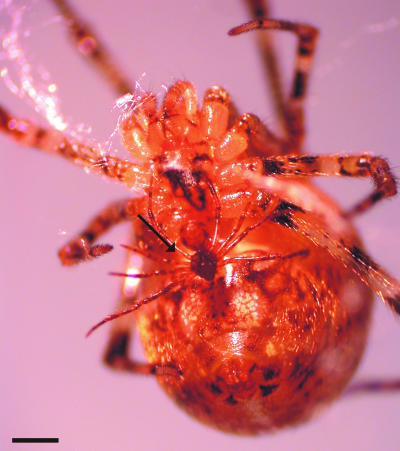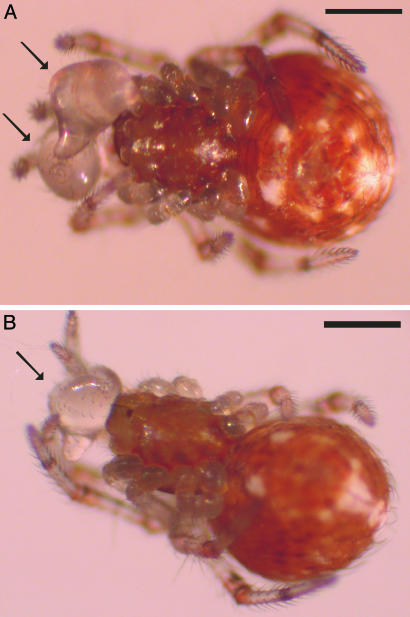Some spiders have a serious problem: runaway evolution sometimes produces maladaptive conditions. Here’s a spider, Tidarren sisyphoides, that exhibits extreme sexual dimorphism — males have about 1% of the mass of the females.

Male and female T. sisyphoides in copula. The minute male (indicated by the arrow) on the female’s ventrum is ≈1% of the female’s mass. (The scale bar represents 1 mm.)
That’s not the problem, though. The problem is that the males maintain a massive pair of palps. Really gigantic. They probably clang when they walk. Look at these two big boys, and the monster intromittent organs dangling from the front of their faces.
You may notice that the top spider has the normal two palps, which are so large that they’re interfering with each other. The bottom spider has only one palp. The surprise is that this is a product of self-mutilation.
During copulation, males generally use both pedipalps in an alternating fashion to inseminate the paired spermathecae in the female. In Tidarren, however, one pedipalp is removed (either left or right pedipalp, seemingly at random) before sexual maturation which has also been described for another spider of similar size and closely related to Tidarren (Echinotheridion). Just after molting to the penultimate instar, the male secures one of its pedipalps to a silk scaffold and then twists it off by turning in circles and pushing the bulb with the third and fourth pairs of legs.
Ouch. There’s a reason for their partial emasculation, though.
We found that, for male Tidarren sisyphoides, maximum speed increased (44%) significantly and endurance increased (63%) significantly after pedipalp removal. Furthermore, spiders with one pedipalp moved approximately 300% greater distances before exhaustion and had a higher survival after exertion than those with two pedipalps. Removal of the pedipalp may have evolved in male Tidarren because of enhanced abilities to search for females (higher endurance and survival after exertion) and to out-compete rival males on the female’s web (higher maximum speed). Our data also highlight how the evolution of conflicts can result in the evolution of a novel behavior.
Not recommended for humans, unless your testicles are the size of basketballs.
Ramos M, Irschick DJ, Christenson TE (2004) Overcoming an evolutionary conflict: removal of a reproductive organ greatly increases locomotor performance. Proc Natl Acad Sci U S A 101(14):4883-7.



Reading this makes my eyes water.
I wonder if the International Olympic Committee has a ruling on this?
This story reminds me that the average person has one testicle.
This story reminds me of one of my favorite messaging test messages.
Testicling, 1, 2, 3… 3?!?!?!
For some odd reason, it’s trivial to find in a message digest or debug log. Never quite figured out why.
Joro spiders everywhere this fall here in Habersham Co. in North Georgia. Large female and smaller male(s) on big webs. This is the first fall I’ve noticed this many. Creeps me out to get tangled up in one of their very strong webs. Shiver! Yeah, I know, they can’t hurt me but still ….ha!
@bcw bcw #2:
Only if you round up from the actual value of about 0.998.
I don’t have a joke here. Kudos to all before me.
I can’t believe that this exists in a natural habitat.
Is this a development in a lab environment?
fishy, of course! The lab’s name is Mother Nature’s Bioterrorism Lab.
I’m sure that many conservative politicians want Mother Nature killed.
Sorry.
I think I need better reading comprehension skills.
It’s fun to learn, isn’t it? Ugh.
I’ll go away now.
Reminds me of the opening line of that dirty ditty allied soldiers sand to the tune of Colonel Bogy’s March.
Also here’s an interesting but probably pointless study, what is the percentage of right-palped vs left palped spiders?
It’s 50/50.
Welcome to the real world. Not so wonderful, but it’s the best we’ve got.
Not really on topic, but close enough.
https://www.abc.net.au/news/2023-10-01/croc-sex-frenzy-rockhampton-chinook-helicopter-aphrodisiac/102914902
(with de apologies to birgerjohansson — but hey, it’s fun, so I emulate more and worry less)
Infrasound. Crocs are rife with it, shithooks even more so, so it’s a mating challenge call to the crocs.
It’s also why I knew a helicopter was within 20 miles. Can’t hear it with my ears, I sense infrasound in my thorax resonating.
In other OT news, apparently, Trump went to a gun shop and allegedly (per his campaign staffers Xits), bought a Glock.
Hope he catches his thumb with the fucking thing.
This is the kind of thing that makes me go, “Really? Some deity DESIGNED this? NONSENSE!”
I wonder if it will be possible for them to evolve lopsided pedipalps like fiddler crabs?
The average number of testicles across the human population is slightly less than 1, which is not at all the same. E.g., the mode of the number of testicles is 0, and the same for the median, given any ordering of humans where the number of testicles are in numerical order.